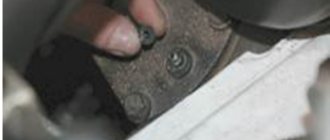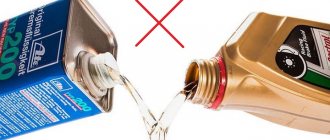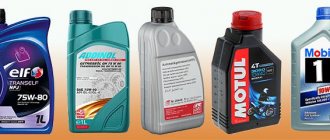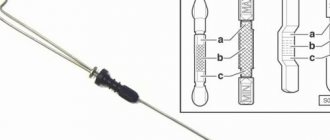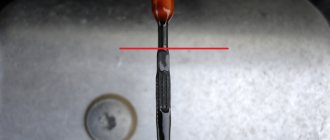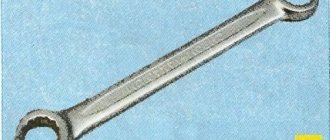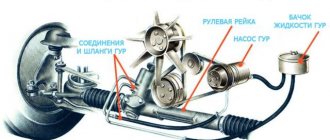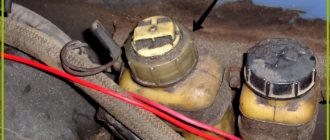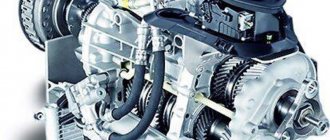It is necessary to dispel the most important myth - the car can be operated even without sufficient fluid in the power steering. The steering wheel will squeak a little, but this load is acceptable. Oil can be added another time.
This is the most common mistake and will lead to the following consequences:
- Lack of pressure in the power steering system due to insufficient oil will damage the power steering pump;
- A malfunctioning system - the steering wheel will take all the impacts and unevenness of the road, increased load on the steering rack, which will ultimately result in new repairs and replacement.
Types and functions of power steering fluid
The hydraulic booster allows you to turn the steering wheel without much effort thanks to the PSF working fluid, which transmits force from the pump to the piston. The quality of the power steering depends precisely on the quality of the PSF and the level of this composition in the system.
The liquid is an oil that performs the following functions:
- protection of system components and elements from corrosion;
- heat removal during friction of parts against each other, preventing overheating of the rubbing parts.
The functionality of the oil depends not least on the additives it contains. In particular, additives affect the foaming properties of the composition.
Often, the quality of a liquid is determined by many car owners only by its color. However, the color of the oil does not completely determine all its properties.
Instead, it is worth considering the main characteristics of the liquid, by which you can judge the quality:
- viscosity;
- foamability;
- hydraulic qualities;
- mechanical qualities;
- Chemical properties.
Power steering oil can be mineral or synthetic. Mineral compounds are usually used due to the presence of rubber elements in the power steering system. Rubber products dry out over time under the influence of significant loads on the steering mechanism, and mineral-based oil has a beneficial effect on rubber parts, extending their service life.
Synthetic power steering fluid is used much less frequently.
We recommend
“How to change wipers on a car: we understand the design and manufacturers” Read more
Power steering oil can be of different colors: red, green or yellow. In this case, you can only mix the red composition with the yellow one. Green oil is not intended to be mixed with others. It is also advisable not to mix synthetic and mineral products with each other.
Synthetic or mineral-based red PSF is typically used only in automatic transmissions. In hydraulic boosters, this fluid is used much less frequently. It is allowed to mix red compounds with yellow ones, provided their characteristics are mutually compatible.
There is a significant selection of power steering oils on the market, produced by a large number of manufacturers. This causes certain difficulties for car owners when choosing the appropriate composition.
Requirements for power steering fluid:
- The composition must be safe for passengers and the driver, since during operation it heats up and partially turns into steam.
- The fluid must operate at high temperatures (over 100 degrees Celsius). Low-quality oil under such conditions can curdle and foam, as a result of which the system’s performance deteriorates until it fails. If the power steering is faulty, the steering wheel will turn, but with much greater force.
- The product should not produce foam.
In addition, the oil must meet the requirements established by the vehicle operating instructions.
This is interesting: Malfunctions of the fuel injection system of the Opel Astra H
What power steering level should be in the reservoir??
Hi all. I periodically look into the fluids, today I discovered that my reservoir of power steering fluid is full, it doesn’t reach the neck by about 1 cm. Plus, it is the color of butter, brown, almost black. Last year (or the year before) I topped it up because... the dipstick was wet at the very tip. I added just a little. There is no level on the dipstick, I can’t determine what the norm is for this unit. I think I’ll even bother replacing the fluid, but I’m a little scared that it could end badly for the pump... And how can the fluid turn black? Workout? I don't understand... it's quite runny. I pull out the dipstick and a drop falls from it.
Astra H 5D, Z18XER 140 hp, cosmo. Dream car!
- 19.05.2014 21:24
Local Bachelor of ASTRAnomy
Message from Salionov
There is no level on the dipstick, I can’t tell
There is a level mark there, look carefully.
OPEL ASTRA H – Z16XER
“handle”, cosmo. - 19.05.2014 21:26
Local Honored Flooder
https://opelastrah.ru/proverka-urovny...ravleniya.html
There was an Astra G hatch x16xel, now there is an Astra H hatch z16xer. Both manual transmissions. And also Chevrolet NIVA LE for bad roads
- 19.05.2014 21:28
Message from VVVolf
I have a white lid with a probe, the probe is about 4-6 cm long, on the base of the probe there is some white garbage that is removed from this probe. There is no level on the dipstick itself, I’ve been trying to find it there for years now))
Astra H 5D, Z18XER 140 hp, cosmo. Dream car!
- 19.05.2014 21:42
Local Honored Flooder
Look at the marks on your tank. In ZF it seems like this
There was an Astra G hatch x16xel, now there is an Astra H hatch z16xer. Both manual transmissions. And also Chevrolet NIVA LE for bad roads
- 19.05.2014 21:49
Yes, I’ve been googling all evening, my tank is ZF, the level is somewhere very deep behind the engine... What about the color? Is it worth taking a steam bath? Mileage 110 thousand. Should I change the fluid? There are no problems with the operation of the power steering, tomorrow I will pump out the excess as I go, apparently I added too much... I thought I should measure it using the dipstick. And what are the dangers of overflowing liquid?
Astra H 5D, Z18XER 140 hp, cosmo. Dream car!
- 20.05.2014 00:41
Local Honored Flooder
Change the fluid and bleed https://opelastrah.ru/prokachka-siste...ravleniya.html Oil seals do not like overflowing fluid.
There was an Astra G hatch x16xel, now there is an Astra H hatch z16xer. Both manual transmissions. And also Chevrolet NIVA LE for bad roads
- 20.05.2014 08:35
Message from VVVolf
Change the fluid
don't you need to hang up the front end? Can I just do it in the parking lot?
Astra H 5D, Z18XER 140 hp, cosmo. Dream car!
- 20.05.2014 09:53
Local Honored Flooder
Don’t bother with the level, the seals don’t care about the level if the pump there gives a pressure of 40 bar. and replacement before 100tkm does not make sense IMHO
- 20.05.2014 10:05
Message from Victor Vasilievich
and replacement before 100tkm does not make sense IMHO
I have 110 thousand mileage
Astra H 5D, Z18XER 140 hp, cosmo. Dream car!
- 20.05.2014 10:17
Local Experienced Astravod
the pump there gives a pressure of 111 bar - 100 atm) so for reference, on the pump itself there is a marking with pressure .. I don’t care how much the level is, as long as it is not lower than the plastic casing inside the bottle, if it is visible then top it up, but in general I would be interested in where the liquid is leaving...
- 20.05.2014 14:21
Message from Warms
where does the slurry go?
Yes, the Christmas trees are matalka. I’m telling you, it doesn’t go away, I overfilled it out of ignorance once! I thought the dipstick should show the level, but on these models it’s not like that.
Astra H 5D, Z18XER 140 hp, cosmo. Dream car!
- 20.05.2014 22:15
Local Honored Flooder
Message from Warms
the pump there gives a pressure of 111 bar - 100 atm) so for reference, there is a pressure marking on the pump itself..
Can you imagine what kind of pressure this is and why it is needed and when the pump reaches this mode?
- 03.04.2015 20:17
Forum members, please tell me, is this a ZF tank? Does it have a dipstick if you unscrew the cap? There are some leaks on the steering rack, but the steering seems to be normal...
«Previous topic|Next topic»
Topic information
Users viewing this topic
This topic is viewed by: 1 (users: 0, guests: 1)
Forum administrator: Admin.
Is it possible to drive with low power steering fluid level?
A leak that appears in the hydraulic booster system always manifests itself in the same way in stages.
At the first stage, with a slight lack of oil while turning the steering wheel, a sound resembling a howl or itching appears in the engine compartment. The sound occurs only when the engine is turned off, gradually fading away as the engine warms up. The steering wheel still turns quite easily.
We recommend
“How to change frameless wipers: complete instructions” Read more
The second stage of level reduction is characterized by an unabating hum, including when the engine is well warmed up. The hum is also heard when turning the steering wheel, but the steering wheel turns a little harder.
Finally, in the third stage, the steering wheel becomes even tighter and the sounds from under the hood disappear. This indicates that all the fluid has already left the power steering system. You can verify this by simply opening the tank lid and looking inside.
Remember! Lack of oil in the power steering will damage the pump, even if you drive only 5 km.
The power steering pump is not designed to operate completely without oil, and most often its rotor pair is damaged (bulged), which cannot be repaired. The only solution to the problem in this case is to purchase a new pump, the cost of which, as a rule, varies between 10-18 thousand rubles and even higher. It will cost significantly more to install a double-circuit pump on a car with hydraulic suspension. Here you will have to pay from 30 to 100 thousand rubles for a new unit.
In such a situation, it is better to use the service of a tow truck. You can try to fill the power steering reservoir with fluid to the minimum level and move around in this way, periodically adding oil as the reservoir becomes empty. However, the supply may not be enough, and then all that remains is to wait for the tow truck.
In the first two stages, despite the low fluid level in the power steering reservoir, you still have the opportunity to drive under your own power, focusing on the sound and compliance of the steering wheel. Until the steering wheel becomes completely stiff and the sound still accompanies its rotation, there is still enough oil in the system for the pump to operate.
It may happen that all the fluid has leaked out of the power steering, and there is no way to call a tow truck. At the same time, even topping up to the minimum level does not save the situation. Here, in order not to damage the pump, it should be completely turned off. The power steering pump in many cars is driven by a separate belt. Accordingly, to stop the pump, this belt should be carefully cut, making sure first that the belt drives only this unit and no other mechanisms will be affected.
Driving with the pump turned off is permitted. But you can drive in this mode no more than 500 km at a speed no higher than 45 km/h. The steering wheel will turn tightly, so it is advisable to drive as straight as possible, without making sharp turns. Driving over a distance of more than 500 km in emergency mode is unacceptable - this will lead to failure of the steering column.
We recommend
“Fine for driving on winter tires: how much will you have to pay” Read more
But what to do if the pump does not turn off by removing the belt? In this case, you can try to close the oil circuit of the pump by running the hose from its output back into the power steering reservoir. The liquid will begin to circulate in the pump, bypassing the steering column, which will operate in the emergency mode described above. Accordingly, you can travel strictly following these requirements.
How to top up
The process of topping up is simple - you need to unscrew the cap of the power steering expansion tank and add enough fluid so that it is between the MIN and MAX marks.
The main problem when adding power steering oil is its choice. It’s good if the replacement has not yet been made, and the system contains fluid from the manufacturer’s factory. In this case, it is enough to check the technical documentation, take the recommended oil and add to the required amount.
If you don’t know what’s in the system, we recommend replacing it right away, because in any case you’ll have to buy a canister of liquid to top up.
It’s a rare car today that doesn’t have a power steering mechanism. This is either an electric power steering (EUR) or a hydraulic power steering (power steering). Both of these mechanisms have both their advantages and disadvantages, but they have the same main function: to reduce the effort required from the driver to rotate the steering wheel.
Side notes:
On luxury cars, the power steering also has one more function: as the vehicle speed increases, it lowers the steering system gear ratio, thereby giving the car greater maneuverability. Similar mechanisms are installed on a number of General Motors vehicles. In Russia, an Opel Astra with such a hydraulic booster is very rare. However, our service center specialists have sufficient qualifications and experience to, if necessary, repair such a mechanism.
Checking the Opel Astra power steering fluid level
Place the car's wheels in a straight ahead position. If the working fluid in the hydraulic system has cooled down, there is no need to start the engine. You can also check cold oil.
| Rice. 5.13 . Checking the fluid level in the hydraulic system reservoir: 1 – reservoir cap; 2 – measuring probe |
The steering hydraulic system reservoir is located at the rear of the engine compartment. Check the level using the indicator on the cover. Unscrew the cap, wipe the indicator rod with a clean cloth and screw it tightly into place. Unscrew the cap again: the level should be 2 mm below or above the “MIN” mark (Fig. 5.13).
If the fluid operating temperature is 50 °C, measure the level in the same way. The level should be between the “MIN” and “MAX” marks.
If the level is higher than normal, then it is necessary to withdraw the fluid. If it is below normal, check the system for leaks or add working fluid.
Video about “Checking the power steering fluid level” for Opel Astra
Opel Astra J 2012 checking the oil level in the automatic transmission.
How to check the oil level in an automatic transmission. Video instruction.
add power steering fluid to the reservoir opel astra h
Other section materials
| Preliminary checks |
| Checking the steering force |
| Checking the steering wheel play |
| Bleeding the power steering system |
| Checking tie rod ends and seals |
| Checking the power steering fluid level |
| Checking constant velocity joints |
| Filling and removing air from the hydraulic system |
| Checking the tightness of the power steering |
This is interesting: Design features of the Opel Astra H cooling system
Fuel system
Fuel tank, Water level sensor, Fuel level sensor, Tank vent valve, Fuel tank button, Fuel tank cap, Fuel neck, Fuel pump, Fuel pump, Fuel pump strainer, Fuel pump gasket, Fuel pump relay, Fuel injector, Injector ring, Throttle valve, Sensor throttle valve, Throttle pipe, Idle air regulator, Air receiver, Throttle valve heating tube, Turbine (turbocharger), Turbine gasket, Solenoid valve, Injection pump, Injection pump valve, Compressor, Compressor gasket, Carburetor, Fuel rail (rail), Fuel pressure regulator , Fuel line, Fuel valve, Fuel hose, Fuel pipe, Air flow meter, Engine control unit, Air pipe, Intake manifold, Intake manifold gasket, Additional air pump, Fuel pump, Gas pedal, Potentiometer, Throttle cable
Power steering device in Opel cars
The power steering on Opel models consists of the following components:
- Closed-loop hydraulic fluid distribution system;
- Pump providing oil supply;
- A tank containing liquid for lubrication and cooling of components;
- Steering mechanism that allows the steering wheel to rotate;
- Fluid supply hoses.
The oil (hydraulic fluid) level is in the reservoir. There are marks on it from the full level to the minimum required. Changing the oil in the power steering on an Opel must be done every 90-120 thousand km. mileage On uneven roads, it is better to lower the replacement test mark and fill it at 80 thousand km. mileage
Partial replacement of power steering fluid in Opel
Oil for power steering on Opel must be filled in provided that its level in the power steering reservoir has dropped to a critical level. We check the possible causes of the leak:
- It is possible that fluid is leaking from the power steering hoses;
- The steering box is damaged;
- The pump is leaking slightly.
Partial replacement process:
- We find the reservoir - in the Opel Astra it is located next to the right front shock absorber strut (if you stand facing the car);
- Check the color and level of the liquid.
- Unscrew the cap and fill the oil to the “Full” mark.
- When performing a partial replacement, do not disconnect the hoses under any circumstances - oxygen entering the system can disable the entire power steering system.
Complete replacement of power steering fluid in Opel
To carry out a complete replacement, you need to prepare the following tools:
- Vacuum syringe - for collecting used lubricant;
- Empty container for collecting oil;
- Screwdriver – for removing clamps on hose clamps;
The replacement process consists of the following steps:
- Draining old fluid from the power steering tank in an Opel is done with a syringe;
- To pump out a full tank, disconnect the fluid return hose;
- We fill the tank with new oil, at the same time the used oil will come out of the recoil hose;
- Fill in the liquid until the level reaches the full mark;
- Connect the recoil hose with the condition that no oxygen enters;
- After connecting, start the engine (at this moment the power steering pump will turn on) and independently turn the steering wheel in different directions several times. This is necessary for a more uniform distribution of lubricant in the system.
Drive unit
How to change the drive belt on a grant fret yourself?
Drive shaft, CV joint (grenade), Outer CV joint, Inner CV joint, Right CV joint, Left CV joint, CV boot, Tripoid, CV joint nut, Retaining ring, Cardan, Crosspiece, Suspension bearing, Cardan bearing, Elastic coupling, Axle, Front axle, Rear axle, Axle reducer, Gearbox bearing, Gearbox oil seal, Differential, All-wheel drive sensor, Haldex coupling, Differential bearing, Differential oil seal, Planetary gears, Axle bearing, Axle shaft, Axle shaft bearing, Axle oil seal, Axle shank, Shank bearing, Axle bearing, Transfer case, Transfer case, Transfer case oil seal, Transfer case bearing, Transfer case chain
Partial replacement for Opel Astra h and other cars
Many motorists carry out only partial fluid changes. That is, if a drop in level is detected, new oil is simply added to the old one (if the liquid leaves too quickly, it is advisable to check the system for leaks).
When topping up, the most important point is the correct selection of new oil.
Ideally, you need to fill in the same liquid that is already in the tank. But, since replacement is carried out quite rarely, it is sometimes not possible to establish the brand of the product.
- Google+
- LJ
- Blogger
The main indicator that car owners should focus on is the base color of the liquid. That is, oil of the same color that is already used is poured into the tank (during operation, the product darkens significantly, so you need to look at the initial indicator).
As a last resort, if the desired color is not available, you can mix yellow and red liquid. However, combining yellow and green is not recommended. If you have a choice between adding a fluid of a different color or transmission oil, then it is better to go with the second option.
Causes of malfunction
The gear and gear base that experience the most stress in the steering rack. Most breakdowns happen to this part of the unit. Among the most common types of breakdowns are:
- tie rod end wear
- tooth wear
- mechanical destruction of teeth
Usually the last two problems are eliminated by adjusting the nut that controls the stop. If the teeth themselves break, you need to replace either the rack or gear. If parts wear out, the technician simply replaces them.
IMPORTANT: if a problem arises and the mechanism needs to be adjusted, contact a specialist so that your car’s steering can be your reliable assistant. The reliability of the entire unit depends on the correctness of the manipulations during adjustment.
The backlash is formed due to poor-quality road surfaces, which we all have to put up with. Driving through obstacles in the form of speed bumps, concrete joints and other irregularities has a detrimental effect on the function of the Opel Astra h steering rack. Also not the least factor is driving style.
ADVICE FROM AN EXPERIENCED CAR OWNER: before potholes and pits, you need to brake the car well. This will not save you from the appearance of backlash, but it will extend the life of the car and delay the breakdown of the part.
After 10-15 years of operation, almost every car experiences difficulties with steering. Foreign manufacturers give an unequivocal recommendation to their customers: replace the device.
But it is not always possible to find the necessary “original” part. Therefore, to eliminate play on the steering wheel, they often use a “tightening” of the mechanism. But when performing it, you need to remember that the life of the gearbox is not endless.
Reviews
Alexey, Moscow region. I have a 2006 Astra H, a model with a 1.6 engine and a manual transmission. It’s clear that for similar money on the second hand you could immediately look at a Volkswagen Golf, but I came across the Astra in perfect condition - with a whole body and bottom, an intact internal combustion engine and gearbox, intact wiring and no oil leaks. I drive with pleasure, despite the stiff suspension. There is also another complaint about the lacquered front panel - it has been covered in scratches for a long time.
Lyudmila, Krasnoyarsk region. I drive a 2015 Astra. A beautiful and stylish car with neat shapes, wherever you look – from the side, front and back it’s simply a sight to behold. Despite the abundance of buttons in the cabin, I quickly got used to the ergonomics - everything is at hand. The 1.4 turbo engine produces 140 horses and instantly propels the Astra from a traffic light.
Power steering
In a separate line, let’s say a few words about power steering. There are two types of these devices used in machines:
- hydraulic
- electric
Power steering
The power steering (hereinafter referred to as GI) is based on the transmission of power from the engine to the rack through a hydraulic device. It is a pump that creates pressure in the GI system. Operates when the engine is on.
Rice. 3. Power steering
Valves on the shaft allow oil to flow into the oil lines. Where the oil goes depends on the direction the steering wheel is turned. This scheme ensures that the wheels turn in the desired direction without unnecessary effort. Malfunctions of the steering wheel with power steering can be in:
- pump
- distributor valves
- piston cylinder system
- cylinder seals
- drive belt
IMPORTANT: such complex faults can only be identified and repaired by professionals.
ADVICE FROM AN EXPERIENCED CAR OWNER: use high-quality motor oils recommended by the manufacturer of your car. Do not skimp on your safety and the safety of your loved ones.
Electric power steering
An electric motor causes the gear to rotate. She moves the gear shaft. Rotation direction sensors send a corresponding signal to the control unit. The engine, in accordance with the received signal, moves the rack in the desired direction. An electric booster (hereinafter referred to as EA) is a fairly reliable device in a car, but breakdowns can occur in it too. For example, they can:
- programs crash
- rotary sensor fails
Rice. 4. Electric power steering
Unlike a power steering unit, an electric amplifier can operate without turning on the engine. The mechanism structure is shown in Figure 4.
Repair of the steering wheel control unit is best carried out at a reputable service station; do not contact private sellers, so as not to permanently damage the part.
IMPORTANT: damage can only be diagnosed using special equipment. Trust this work to professionals.
For example, to find out whether a backlash is a deviation from the norm, you need to know the standard embedded in the part. Usually this figure is equal to 9-10 degrees. To measure it, you need a special device - a backlash meter. If you don’t have one, contact a service station.
Video “Connecting the tester to the Opel Astra”
You can learn more about connecting the diagnostic tester to an Opel Astra car from the video.
Some Opel Astra N cars are equipped with power steering, so the owners of such cars must carefully comply with all requirements for their operation and monitor the serviceability of the electronics. Power steering is a very important part that ensures driving comfort and safety, so if the slightest breakdown occurs, you should immediately seek help from professionals. Our Autopilot service center employs experienced craftsmen with excellent skills who have been repairing Opel Astra N power steering in Moscow for many years.
Oil pressure sensor
If the oil pressure sensor lights up on a Volkswagen Polo, then a fascinating set of checks of the engine and individual components awaits you. What could cause the sensor to light up?
- Low level of oil pressure in the engine. The simplest option is to check the dipstick, if you add too little to the required level.
- Oil too old. Look at the color of the oil, rub it with your fingers (you should feel oily). If the oil is too old, it is better to change it to a new one.
- Oil pump malfunction.
- The oil pressure sensor has failed. If you checked the previous steps and nothing helped, check the sensor itself. A visual inspection will help determine the external condition of the device. If necessary, replace with a new one. It happens that the sensor is covered in oil, this may indicate that the leak is coming through the sensor. Of course, such a part must be replaced immediately.
How to replace
Replacing the sensor does not require much effort. At the rear of the cylinder block (where the unit number is indicated), press the wire lock and remove the terminal. The sensor itself is unscrewed with a key x 22. When installing a new sensor, make sure that there is a sealing washer.
Engine
Cylinder head, Valve, Valve springs, Valve rocker (rocker arm), Valve retainer, Intake valve, Exhaust valve, Hydraulic lifters, Valve seals, Valve lifter, Valve cover, Oil filler cap, Valve cover gasket, Cylinder head gasket, Camshaft, Camshaft oil seal , Camshaft gear, Intermediate shaft, Cylinder head bolt, Valve guide, Vtec valve, Vtec valve gasket, Oil pipe, Cylinder block, Crankshaft, Crankshaft pulley, Pulley bolt, Crankshaft bolt, Main bearings, Crankshaft cover (yoke), Oil deflector, Half rings , Crankshaft oil seal, Crankshaft hub, Crankshaft gear, Piston, Piston rings, Piston pin, Connecting rod, Connecting rod bolt, Connecting rod bearings, Connecting rod bushing, Engine sump, Pan gasket, Drain plug, Cylinder liner, Oil pump, Oil pump chain, Oil gasket pump, Oil receiver, Oil separator, Oil nozzle, Balance shaft, Filter housing, Engine cover, Engine timing belt, Timing belt, Timing kit, Timing belt roller, Timing tensioner, Timing tensioner roller, Timing chain, Chain kit, Chain tensioner, Chain tensioner , Phase adjuster, Timing gear, Timing belt cover, Timing cover gasket, Engine mount, Engine bracket, Engine bump stop, Engine mount (support), Engine assembly, Engine gaskets, Engine sensors, Engine oil cooler, Oil filter mount, Oil filter gasket , Engine casing, Engine protection, Engine pipe, Oil dipstick https://www.youtube.com/watch?v=Nqu_2zOCC7Q
